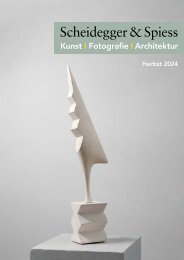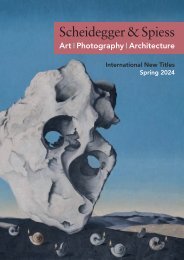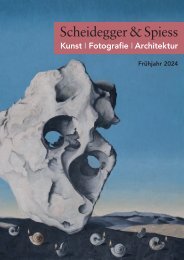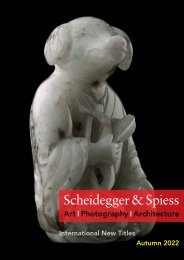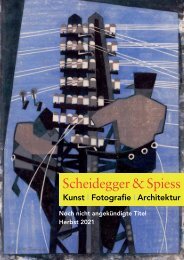Scheidegger & Spiess International New Titles Spring 2021
New books to come in Spring 2021 from Swiss publishing house Scheidegger & Spiess: The latest work of famous designer Ludovic Balland, contemporary art and award winning photography!
New books to come in Spring 2021 from Swiss publishing house Scheidegger & Spiess: The latest work of famous designer Ludovic Balland, contemporary art and award winning photography!
Create successful ePaper yourself
Turn your PDF publications into a flip-book with our unique Google optimized e-Paper software.
Oskar Bätschmann
Edited by Angelika Affentranger-
Kirchrath
Book design by Arturo Andreani
Hardback
approx. 96 pages
40 color illustrations
21.5 × 25 cm
978-3-03942-011-7
English / German
sFr. 29.00 | € 29.00
£ 25.00 | $ 29.00
A profound study of Paul Klee’s
painting Ad Parnassum, a key work
in the painter’s oeuvre
Examines the origins of Klee’s
search for polyphonic painting
analogous to polyphonic music
APRIL 2021 (Europe)
JULY 2021 (US)
ISBN 978-3-03942-011-7
9 783039 420117
Paul Klee—Ad Parnassum
Landmarks of Swiss Art
In the 1920s, German-Swiss artist Paul Klee (1879–1940) began his long-lasting
engagement with polyphonic art—a multi-voiced way of painting analogous to music.
A relentless experimenter, Klee began these studies while teaching at the Bauhaus in
Dessau, developed them further during his tenure at the art academy in Düsseldorf,
and brought them to conclusion after his return to Switzerland in 1933. In this
book, distinguished art historian Oskar Bätschmann explores Klee’s seminal painting
Ad Parnassum (1932). Painted shortly after the artist’s departure from the Bauhaus, it
symbolizes a new era, also one of Klee’s own self-discovery. Bätschmann documents
how the artist strove for a connection of music and painting in his color hues and in
the rhythmic movement of colored dots.
Richly illustrated, this book places Klee’s polyphonic understanding of art in an arthistorical
context by using this key work as an example and offers insight into the
synesthetic thinking that emerged in the art world during that time.
Oskar Bätschmann is professor emeritus of early modern art history at
the University of Bern. He was a member of the Paul Klee Foundation and
co-initiator of the artist’s Catologue raisonné, published from 1998 to 2004.
Scheidegger & Spiess
Spring 2021 7




